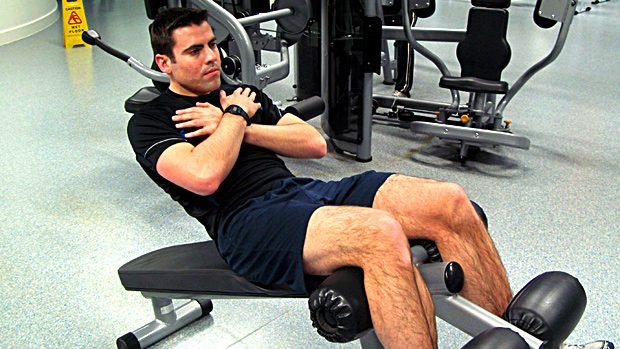Decline bench sit-ups offer a challenging twist to traditional sit-ups, engaging your core muscles with added resistance. This guide delves into the intricacies of decline bench sit-ups, providing step-by-step instructions, insights into the muscles engaged, benefits, variations, alternatives, common mistakes, and essential considerations to help you master this effective abdominal exercise.
Muscles Worked:
Primary Muscles:
- Rectus Abdominis (Front Abs)
Secondary Muscles:
- Hip Flexors
- Obliques (Side Abs)
- Transverse Abdominis (Deep Core)
How to Perform Decline Bench Sit-Ups:
- Setup: Secure your feet under the footpads of a decline bench. Lie down with your back on the bench, facing upward.
- Engagement: Cross your arms over your chest or place your hands behind your head. Engage your core.
- Sit-Up: Use your core muscles to lift your upper body off the bench while maintaining a controlled motion.
- Contraction: Focus on contracting your abdominal muscles as you reach the top of the sit-up.
- Lowering: Slowly lower your upper body back down to the bench while maintaining control.
- Repetition: Complete the desired reps while ensuring proper form and controlled movement.
Benefits of Decline Bench Sit-Ups:
- Enhanced Core Engagement: The declined position increases the resistance on the abdominal muscles, intensifying the workout.
- Hip Flexor Activation: Engages the hip flexors as you lift your upper body off the bench.
- Variation: Offers a challenging alternative to traditional sit-ups, targeting different areas of the abdominal muscles.
- Full Range of Motion: Allows for a deeper range of motion compared to flat bench sit-ups.
Variations:
1. Weighted Decline Bench Sit-Ups:
- Hold a weight plate or dumbbell against your chest during the sit-up for added resistance.
2. Twist Variation:
- Incorporate a twist at the top of the sit-up to engage the oblique muscles.
Alternatives:
1. Decline Bench Leg Raises:
- Instead of sitting up, lift your legs off the bench, engaging the lower abdominal muscles.
2. Hanging Leg Raises:
- Perform leg raises while hanging from a bar, targeting the core and hip flexor muscles.
Common Mistakes to Avoid:
- Using Momentum: Perform the sit-up using controlled muscle contraction, not relying on swinging.
- Neck Strain: Avoid pulling on your neck with your hands; let your core muscles do the work.
- Lack of Core Activation: Ensure your core muscles are engaged throughout the movement.
Key Considerations:
- Foot Position: Secure your feet under the footpads firmly to prevent sliding.
- Breathing: Exhale as you contract your abs and inhale as you lower yourself back down.
- Progression: Gradually increase the incline or resistance as your core strength improves.
Conclusion:
Decline bench sit-ups provide an excellent opportunity to challenge and develop your core strength. By mastering their execution, understanding the muscles engaged, appreciating the benefits, exploring variations and alternatives, avoiding common mistakes, and considering key factors, you can seamlessly integrate decline bench sit-ups into your fitness routine. Approach this exercise with dedication, proper form, and a commitment to achieving a strong and defined core for optimal results.
